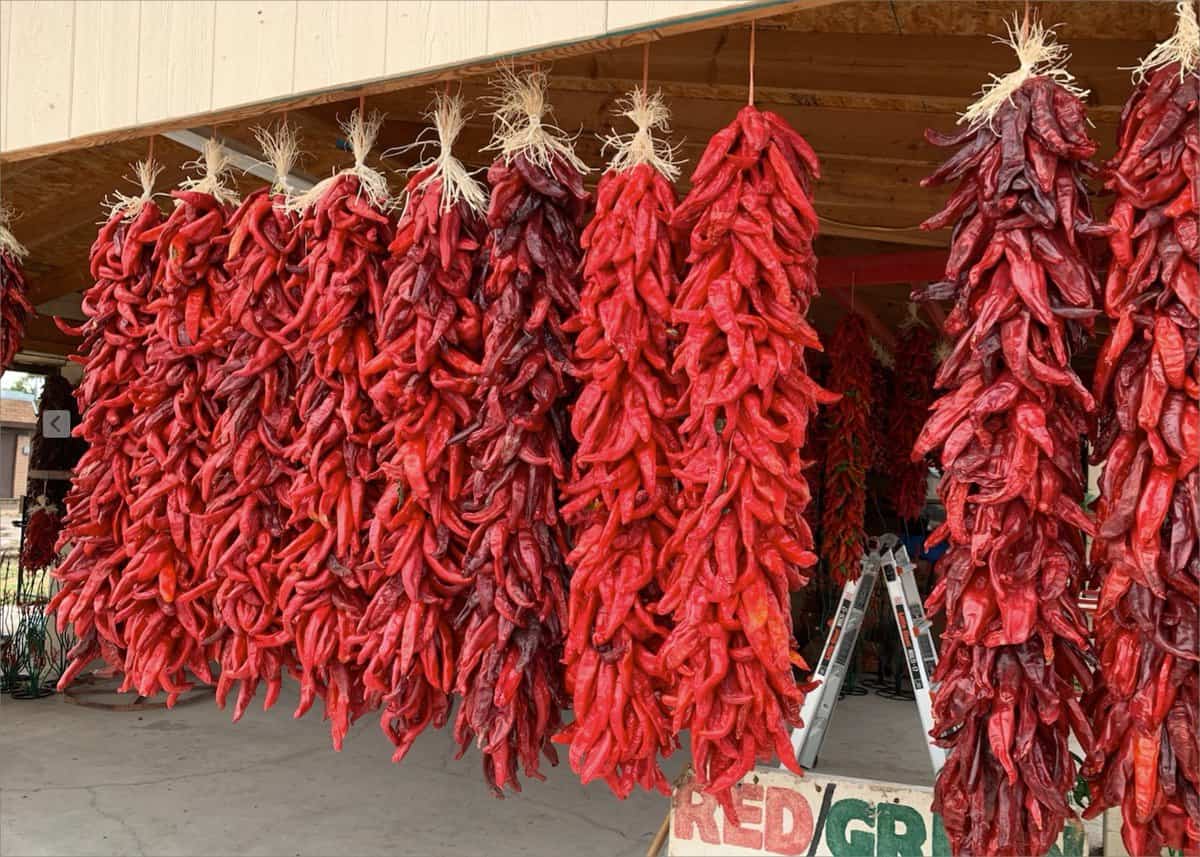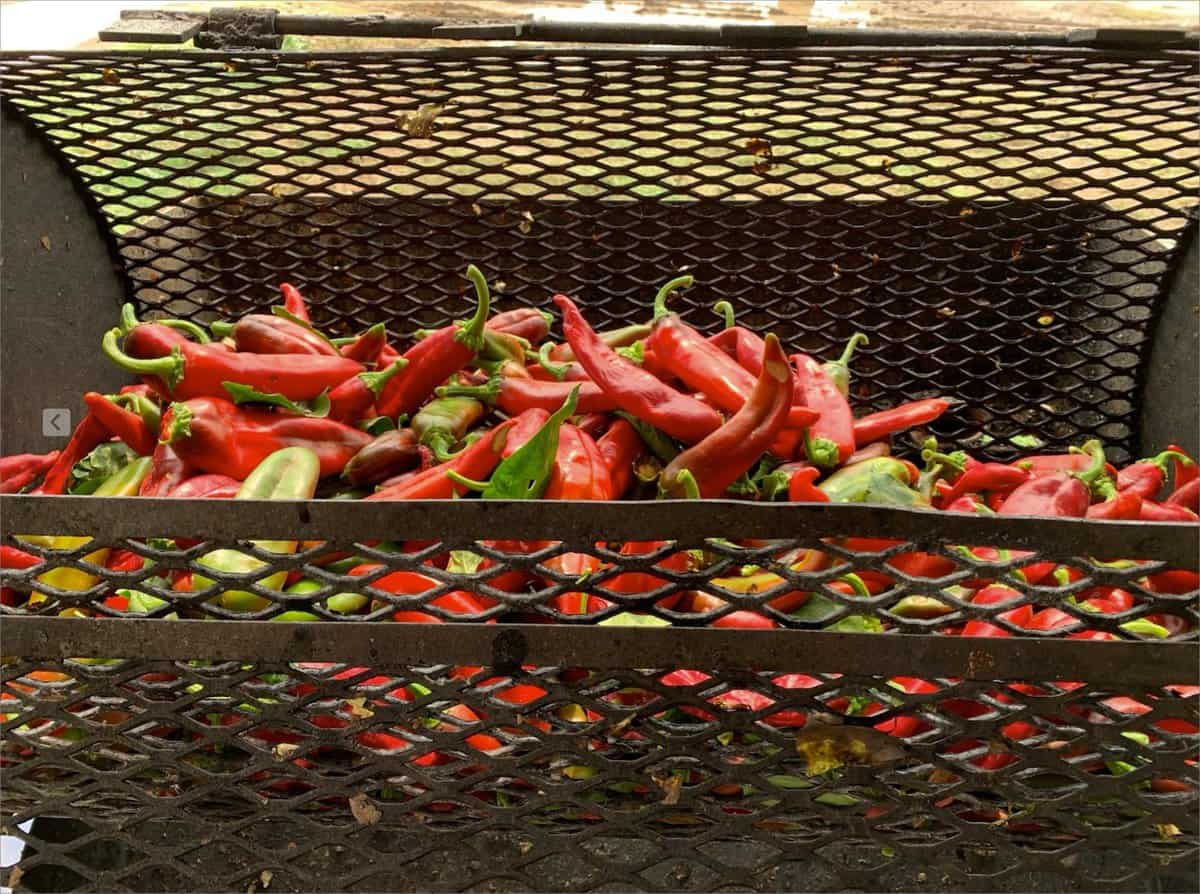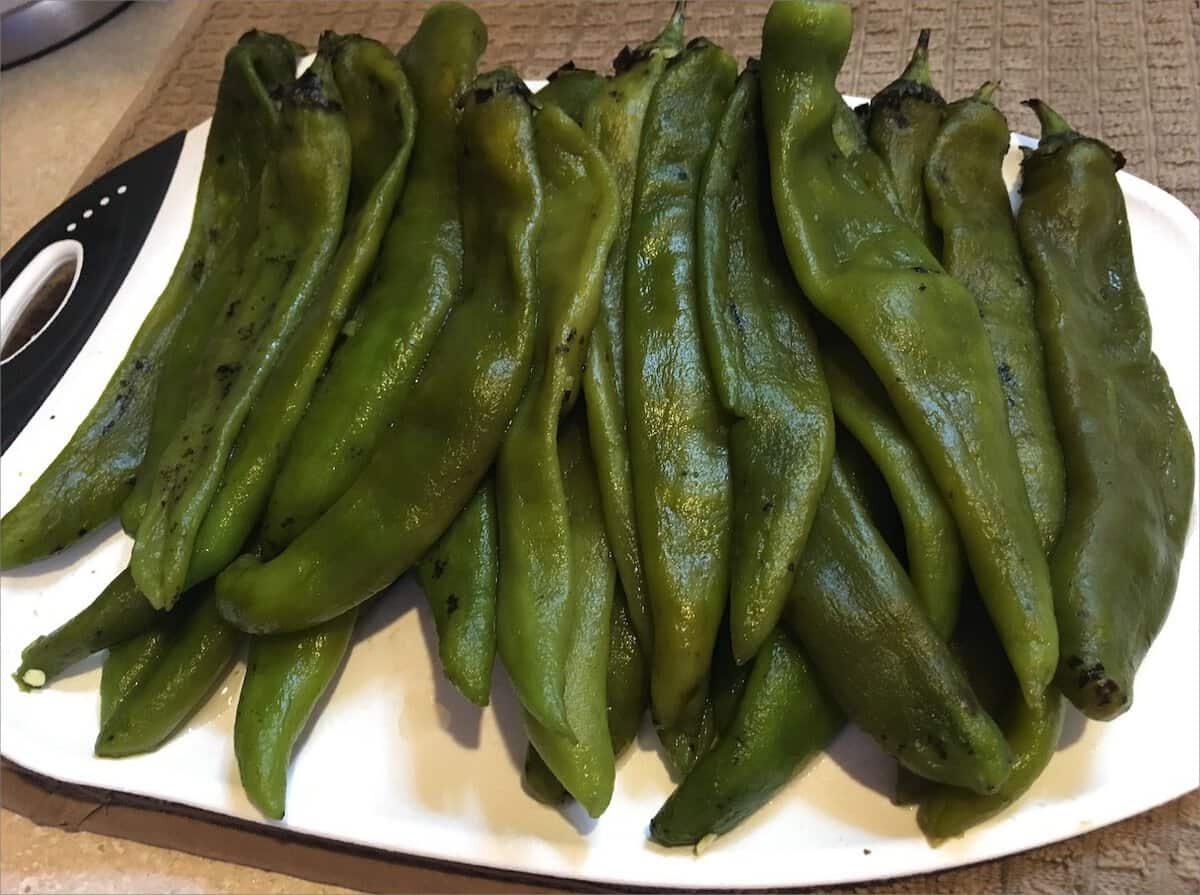Table of Contents
Chile peppers have become an integral part of New Mexican cuisine and culture. The state’s arid climate and fertile soil make it an ideal location for growing these spicy peppers. The history of chile peppers in New Mexico dates back centuries and has played a significant role in shaping the state’s identity.
The origins of chile peppers in New Mexico can be traced back to the arrival of Spanish colonizers in the 16th century. These colonizers brought with them a variety of crops, including chile peppers, which were quickly adopted by the indigenous population. Over time, the chile pepper became a staple of New Mexican cuisine, with various varieties being developed to suit local tastes.

Key Takeaways
- Chile peppers have a long and rich history in New Mexico, dating back to the arrival of Spanish colonizers in the 16th century.
- Over time, a variety of chile pepper varieties were developed to suit local tastes.
- Today, chile peppers continue to play an important role in New Mexican cuisine and culture, as well as the state’s economy.
Origins of Chile Peppers in New Mexico
Chile peppers have a long and rich history in New Mexico. The origins of chile peppers in New Mexico can be traced back to the pre-Columbian and Spanish influences in the region.
Pre-Columbian and Spanish Influences
Before the arrival of the Spanish, chile peppers were already being cultivated and consumed in Mexico. The chile pepper was an important part of the culture and agriculture of the native people of Mexico. The Spanish brought chile peppers to New Mexico in the 16th century, and they quickly became a staple food in the region.
The chile pepper was not only used as a food source, but it also had medicinal and spiritual significance. The native people of Mexico believed that the chile pepper had healing properties and used it to treat a variety of ailments. They also used the chile pepper in religious ceremonies and believed that it had the power to ward off evil spirits.
Early Cultivation and Trade
The cultivation of chile peppers in New Mexico began in the early 17th century. The Spanish settlers introduced the chile pepper to the Pueblo Indians, who quickly adopted it into their diet. The Pueblo Indians began to cultivate chile peppers and trade them with other tribes in the region.
The cultivation of chile peppers in New Mexico expanded rapidly in the 18th and 19th centuries. The chile pepper became an important cash crop for the region, and it was traded with other parts of the New World and Europe. The chile pepper also became an important part of the cuisine of New Mexico and is still a staple food in the region today.
In conclusion, the origins of chile peppers in New Mexico can be traced back to the pre-Columbian and Spanish influences in the region. The chile pepper was an important part of the culture and agriculture of the native people of Mexico, and it quickly became a staple food in New Mexico after the arrival of the Spanish. The cultivation of chile peppers in New Mexico expanded rapidly in the 18th and 19th centuries, and it became an important cash crop for the region.
Development of Chile Pepper Varieties
The development of chile pepper varieties in New Mexico can be traced back to Fabian Garcia, a horticulturist at New Mexico State University. Garcia began his work in the early 1900s, and his efforts led to the creation of the New Mexico No. 9, a cultivar that became the foundation for the state’s chile pepper industry.
Fabian Garcia and the New Mexico No. 9
Garcia’s work involved crossbreeding different chile pepper varieties to create a plant that was better suited to New Mexico’s climate and soil. In 1913, he released the New Mexico No. 9, which quickly became popular with farmers and consumers alike. This cultivar had thicker walls, a milder flavor, and a more consistent size than other chile peppers grown in the area.
Creation of the New Mexican Pod Type
In the 1920s, New Mexico State University continued to work on developing new chile pepper varieties. One of the most significant breakthroughs was the creation of the New Mexican pod type, which is now the most commonly grown chile pepper in the state. This variety has a long, narrow shape and a mild to medium heat level, making it ideal for use in traditional New Mexican dishes like green chile stew and red chile enchiladas.
Landrace Varieties and Their Evolution
In addition to cultivars like the New Mexico No. 9 and the New Mexican pod type, New Mexico is also home to a variety of landrace chile peppers. These are plants that have evolved over time to adapt to their local environment, and they often have unique flavors and characteristics. Some of the most well-known landrace chile peppers in New Mexico include Sandia, Big Jim, and Chimayo.
Over the years, New Mexico State University has continued to work on developing new chile pepper varieties. Some of the most recent cultivars include Numex Joe E. Parker, which has a mild heat level and is popular for roasting, and Numex Big Jim, which is a larger version of the original Big Jim cultivar. Other notable varieties include Numex Española Improved, Numex Heritage 6-4, and Numex Conquistador.
Overall, the development of chile pepper varieties in New Mexico has been a long and ongoing process. Thanks to the hard work of researchers at New Mexico State University and generations of farmers, the state’s chile pepper industry continues to thrive and produce some of the most delicious and unique peppers in the world.
Chile Pepper Agriculture in New Mexico
Chile pepper agriculture has been an integral part of New Mexico’s history and economy for centuries. Today, the state is known for its unique varieties of chile peppers, including the famous Hatch chile, grown in the Hatch Valley region of southern New Mexico.
Farming Regions and Their Significance
Chile peppers are grown in various regions of New Mexico, including the Rio Grande Valley, Dona Ana, Luna, and Sandoval counties. The Hatch Valley region, located in the southern part of the state, is particularly renowned for its chile pepper production and is home to the annual Hatch Chile Festival.
Soil and Climate Impact
The environment, soil, and climate of New Mexico play a significant role in the growth and development of chile peppers. The state’s arid climate and unique terroir provide ideal conditions for growing chile peppers, which require low humidity and plenty of sunlight. However, hail and other weather-related hazards can pose a threat to chile pepper crops.
Agricultural Practices and Mechanization
Over the years, agricultural practices have evolved to meet the demands of the industry. Today, many chile pepper farms in New Mexico use mechanization to aid in the planting, harvesting, and processing of chile peppers. However, traditional farming methods, such as handpicking mature fruit, are still practiced by some farmers.
Overall, the history of chile pepper agriculture in New Mexico is rich and varied, with many unique factors contributing to the state’s success in the industry.

Culinary and Cultural Significance
Traditional New Mexican Dishes
New Mexican cuisine is famous for its unique and delicious dishes that are centered around the use of chile peppers. The New Mexican pod type chile pepper, also known as the green chile pepper, is the backbone of New Mexican cuisine. It is used in a variety of dishes such as enchiladas, chile rellenos, and stews. The chile pepper is often roasted and used in sauces to add flavor and depth to the dishes. The heat level of the chile pepper can vary from mild to hot, making it versatile for different palates.
Chile as a Cultural Symbol
Chile peppers have become a cultural symbol of New Mexico, often referred to as the “Land of Enchantment.” The Hatch and Santa Fe regions in New Mexico are particularly famous for their chile peppers. Chile peppers are not only a staple in New Mexican cuisine but also represent the state’s cultural identity. The chile pepper is celebrated in festivals such as the Hatch Chile Festival and the Santa Fe Wine and Chile Festival, which draw crowds from all over the world.

Festivals and Local Markets
Local markets in New Mexico are filled with chile peppers in all forms, including fresh, dried, and ground. The chile pepper is also used to make decorative ristras, which are strings of dried chile peppers. These ristras are often hung on the front porch of homes and are believed to bring good luck. In addition to local markets, chile peppers are also sold at festivals such as the Hatch Chile Festival, which is held annually in Hatch, New Mexico. These festivals offer visitors the opportunity to taste different varieties of chile peppers and learn more about their history and significance.
Overall, chile peppers have played a significant role in New Mexican cuisine and culture for centuries. They are an integral part of traditional dishes and are celebrated in festivals and local markets. The New Mexican pod type chile pepper is a unique and important ingredient that has put New Mexico on the map as a culinary and cultural destination.
Scientific Research and Education
Chile Pepper Institute’s Role
The Chile Pepper Institute (CPI) at New Mexico State University has played a significant role in advancing the scientific research and education of chile peppers in New Mexico. Established in 1992, CPI is the only international, non-profit organization devoted to chile peppers. CPI’s mission is to educate the public about the importance of chile peppers and to promote research on the crop. CPI has been instrumental in promoting the state’s official vegetable, the New Mexico Chile, and the Hatch Chile, which is one of the most popular varieties of chile peppers in the world.
Academic Contributions and Discoveries
Academic institutions in New Mexico have contributed significantly to the scientific research and education of chile peppers. Fabián Garcia, an early pioneer in the New Mexico chile pepper industry, was the first to conduct systematic research on chile peppers. His work led to the development of the New Mexico chile pepper, which is now a state symbol.
Academic research has also led to the discovery of capsaicin, the compound responsible for the heat in chile peppers. Capsaicin has been found to have many health benefits, including pain relief and improved digestion. In addition, academic research has led to the development of new chile pepper varieties, such as Capsicum annuum and C. chinense.
Academic research has also contributed to the development of new chile pepper products, such as Tabasco and paprika. HortScience, a scientific journal, has published many research papers on chile peppers, including the effects of different growing conditions on the crop.
Overall, the scientific research and education of chile peppers in New Mexico has led to many discoveries and advancements in the field. The CPI and academic institutions have played a vital role in promoting the crop and educating the public about its importance.
Economic Impact and Industry
Chile Pepper Production and Sales
The cultivation and sale of chile peppers have had a significant impact on the economy of New Mexico for over a century. According to a study by the University of New Mexico, the chile industry in southern New Mexico began to take off in the early 1900s, kickstarting the economic colonization of farmers in the region. The state’s chile industry has since grown to become a major contributor to the state’s economy, with chile pepper production generating over $400 million in revenue annually.
New Mexico chile peppers are highly sought after for their unique flavor and heat profile, with the Hatch chile being one of the most popular varieties. The state’s chile peppers are grown in a range of mild to hot varieties, including the Sandia, Santa Fe, and New Mexico No. 9. The Hatch chile, in particular, has become a cultural icon and is celebrated every year during the Hatch Chile Festival.

Impact on Local and National Economies
The chile pepper industry has had a positive impact on both local and national economies. In addition to generating revenue for farmers and producers, the industry has also created jobs in processing, packaging, and distribution. The industry has also led to the development of related industries such as sauces, spices, and other food products that incorporate chile peppers.
The chile pepper industry has also helped to promote New Mexico’s unique culinary culture and attract tourists to the state. Chile peppers are a staple ingredient in many traditional New Mexican dishes, including chile rellenos, enchiladas, and posole. Many local markets in the state feature fresh chile peppers, and the industry has helped to create a demand for New Mexico chile peppers in national and international markets.
As the industry has grown, there has been a push for mechanization to help increase efficiency and reduce labor costs. The development of the Numex Heritage 6-4 cultivar has also helped to increase yields and improve disease resistance. However, there is still a strong tradition of landrace cultivation in northern New Mexico, where farmers continue to grow and sell heirloom varieties of chile peppers.
Overall, the chile pepper industry has played a significant role in the economy and culture of New Mexico. From its humble beginnings in southern New Mexico to its current status as a major contributor to the state’s economy, the chile pepper industry has helped to shape the identity of the state and its people.
Frequently Asked Questions
What is the origin of chile peppers in the Americas?
Chile peppers have been cultivated in the Americas for thousands of years. The earliest evidence of chile pepper consumption dates back to around 7500 BCE in present-day Mexico. Archaeological evidence suggests that chile peppers were domesticated in Mexico and spread throughout the Americas.
How did Hatch green chiles become a symbol of New Mexican cuisine?
Hatch green chiles are a variety of chile pepper that is grown in the Hatch Valley in southern New Mexico. The chiles are known for their unique flavor and are a staple of New Mexican cuisine. Hatch green chiles were first grown in the early 20th century and quickly became popular in the region. Today, Hatch green chiles are an important part of New Mexican culture and cuisine.
What distinguishes New Mexico chile from other varieties like Guajillo?
New Mexico chile is a variety of chile pepper that is grown in New Mexico. The chiles are known for their unique flavor and heat level. New Mexico chiles are typically milder than other varieties like Guajillo and have a slightly sweet taste.
Can you trace the historical significance of chile peppers in New Mexico’s culture?
Chile peppers have played an important role in New Mexican culture for centuries. The indigenous people of the region used chile peppers in their cuisine and as a medicine. When the Spanish arrived in the 16th century, they introduced new varieties of chile peppers to the region. Today, chile peppers are an important part of New Mexican culture and cuisine.
How do the Scoville ratings of New Mexico chiles compare to other peppers?
The Scoville scale is a measure of the heat level of chile peppers. New Mexico chiles typically have a Scoville rating of 500 to 2,500, which is considered to be mild to medium heat. Other peppers like the Habanero can have a Scoville rating of up to 350,000, making them extremely hot.
What are the key historical milestones in the cultivation of chile peppers in New Mexico?
Chile peppers have been cultivated in New Mexico for centuries. In the early 20th century, the Hatch Valley became a major producer of chile peppers. In the 1970s, the state of New Mexico began to promote its chile peppers as a tourist attraction. Today, New Mexico chile peppers are an important part of the state’s economy and culture.




